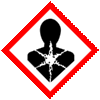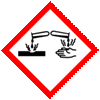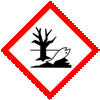 |
King of Chemicals Manufacturers |
Specifications, Properties, Uses, SDS of Hydroquinone Hydroquinone or Quinol USP BP Ph Eur Grade Manufacturer Supplier Exporter Wholesale & Small Packs, CAS Number 123-31-9. |
|
| King of Chemicals has several associated companies having accreditations like cGMP, GLP - FDA Approved Good Manufacturing Practice and Good Laboratory Practice of WHO standard, ISO-9001, ISO-14001, ISO/IEC 17025, ISO ISO-45000, HACCP, FSSC 220000, FSSAI, "REACH" Registered, Kosher & Halal Certified. e-CTD and DMF support can be made available if needed. We offer USP NF BP Ph Eur EP IP JP Analytical Reagent FCC Food Grade Chemicals & Nutraceuticals. | |
        |
|
Muby Chem Pvt. Ltd. is a several decades old group of companies, engaged in manufacturing, supplying, distributing, wholesale supplies of Hydroquinone or 1,4-Benzenediol or Quinol for actual users, including retail or small pack supplies for research and development work.
We supply fine and speciality chemicals, pharmaceutical excipients, mineral fortifiers in chemically pure, analytical reagent grade, IP BP USP Ph Eur EP JP and other pharmaceutical grade monograph including FCC Food grade chemicals and Nutraceuticals at best prices. We and/or our associated units have all the facilities to supply as per cGMP standard observing good manufacturing practice and good laboratory practice. We can assure low microbial count and also offer a test certificate for the same. We maintain warehouses across USA, India, and UAE. Our group exports to USA, Canada, Mexico, Argentina, Brazil, Chile, Korea, Malaysia, Thailand, Indonesia, Europe, and several other parts of the world. We supply in wholesale container loads to small pack of few grams. Solid products may be specified for it size and shape as desired by the buyer.








Hydroquinone Hydroquinone or Quinol CAS Number 123-31-9
For Properties Specifications Uses of Hydroquinone Hydroquinone or Quinol Click Properties, Specifications, Uses, Price, Process of Hydroquinone Hydroquinone or Quinol Manufacturer.
For For SDS MSDS Sheet of Hydroquinone Hydroquinone or Quinol Click SDS Safety Data Sheet MSDS Sheet of Hydroquinone Hydroquinone or Quinol Manufacturer.
The Properties, Specifications, Monograph and Uses of Hydroquinone Hydroquinone or Quinol:
Hydroquinone or 1,4-Benzenediol or 1,4-Dihydroxybenzene or HQ or Quinol is an aromatic organic compound having the chemical formula C6H4(OH)2. Hydroquinone is a depigmenting agent used to lighten areas of darkened skin. It is also used as an inhibitor, an antioxidant, and an intermediate in the synthesis of dyes, motor fuels and oils, in photographic processing.
Hydroquinone USP Grade Specifications:
C6H6O2 --- 110.11
1,4-Benzenediol.
Hydroquinone CAS 123-31-9.
Hydroquinone contains not less than 99.0 percent and not more than 100.5 percent of C6H6O2 ;calculated on the anhydrous basis.
Packaging and storage: Preserve in tight, light-resistant containers.
Identification:
A: ;Infrared Absorption.
B: To pass the chromatography test.
C: A 1 in 40,000 solution in methanol exhibits an absorbance maximum at 293 ± 2 nm.
Melting range: between 172C and 174C.
Water Determination: not more than 0.5%.
Residue on ignition: not more than 0.5%.
Specifications of Hydroquinone BP Ph Eur Grade:
C6H6O2 --- 110.11 --- CAS Number 123-31-9
Action and use: Depigmenting agent.
DEFINITION
Hydroquinone is 1,4-benzenediol. It contains not less than 99.0% and not more than 100.5% of C6H6O2, calculated with reference to the anhydrous substance.
CHARACTERISTICS
Fine white or almost white needles, which darken on exposure to light and air.
Freely soluble in water, in ethanol (96%) and in ether.
IDENTIFICATION
A. The light absorption in the range 230 to 350 nm, of a 0.0025% w/v solution in methanol exhibits a maximum at 293 nm.
B. To pass the test.
TESTS
Melting point: 172C to 174C.
Water: Not more than 0.5%,
Sulfated ash: Not more than 0.5% w/w.
The MSDS-SDS Hazard Statement of Hydroquinone Hydroquinone or Quinol:
Hydroquinone or 1,4-Benzenediol or 1,4-Dihydroxybenzene or HQ or Quinol
SDS, Safety Data Sheet
MSDS, Material Safety Data Sheet 26-Feb-22
1. Product Identification
Product Name & Other Names: Hydroquinone or 1,4-Benzenediol or 1,4-Dihydroxybenzene or HQ or Quinol.
CAS No.: 123-31-9
EINECS EC Number: 204-617-8
Relevant uses and uses advised against (if any): Industrial Manufacturing.
Suppliers: As per letterhead.
2. Hazards Identification
GHS, Globally Harmonized System Classification in accordance with 29 CFR 1910
Classification according to Regulation (EC) No 1272/2008
Acute toxicity, Oral Category 4, H302
Skin sensitization Category 1, H317
Serious eye damage Category 1, H318
Germ cell mutagenicity (Category 2), H341
Carcinogenicity Category 2, H351
Hazardous to the aquatic environment, long-term hazard Category 1, H410
Labeling according to Regulation (EC) No 1272/2008
GHS Label Elements  Health Hazard |
GHS Label Elements |
GHS Label Elements |
Signal Words: Danger
Hazard statements:
H302: Harmful if swallowed.
H317: May cause an allergic skin reaction.
H318: Causes serious eye damage.
H341: Suspected of causing genetic defects.
H351: Suspected of causing cancer.
H410: Very toxic to aquatic life with long lasting effects.
Precautionary statements:
P201: Obtain special instructions before use.
P202: Do not handle until all safety precautions have been read and understood.
P264: Wash thoroughly after handling.
P270: Do not eat, drink or smoke when using this product.
P273: Avoid release to the environment.
P280: Wear protective gloves/protective clothing/eye protection/face protection.
P281: Use personal protective equipment as required.
P312: Call a POISON CENTER or doctor/physician if you feel unwell.
P330 : Rinse mouth
P301+P312: IF SWALLOWED: Call a POISON CENTER or doctor/ physician if you feel unwell.
P305+P351+P338: IF IN EYES: Rinse cautiously with water for several minutes. Remove contact lenses, if present and easy to do. Continue rinsing.
P308+313: IF exposed or concerned: Get medical advice/attention.
P391: Collect spillage.
P405: Store locked up.
3. Composition/Information on Ingredients
Product Name & Other Names: Hydroquinone or 1,4-Benzenediol or 1,4-Dihydroxybenzene or HQ or Quinol.
CAS No.: 123-31-9
EINECS EC Number: 204-617-8
4. First Aid Measures
Always seek medical attention after first aid measures are provided.
Inhalation: Allow the victim to rest in a well-ventilated area. Seek immediate medical attention.
Ingestion: Give large amounts of water to drink. Never give anything by mouth to an unconscious person. Get medical attention.
Skin Contact: Immediately flush skin with plenty of soap and water for at least 15 minutes. Remove contaminated clothing and shoes and wash before reuse. Get medical attention if irritation develops.
Eye Contact: Immediately flush eyes with running water for at least 15 minutes, keeping eyelids open. Cold water may be used. Get medical attention immediately.
5. Fire Fighting Measures
Fire: As with most organic solids, fire is possible at elevated temperatures or by contact with an ignition source.
Explosion: Fine dust dispersed in air in sufficient concentrations, and in the presence of an ignition source is a potential dust explosion hazard.
Fire Extinguishing Media: Water spray, dry chemical, alcohol foam, or carbon dioxide.
Extinguishing Media Not recommended: Avoid using solid water jet as it may scatter the fire.
Special Information: In the event of a fire, wear full protective clothing and NIOSH-approved self-contained breathing apparatus with full face piece operated in the pressure demand or other positive pressure mode. At high temperatures under fire conditions, it may produce toxic or irritating fumes. Fire-extinguishing work is done from the windward and the suitable fire-extinguishing method according to the surrounding situation is used. Uninvolved persons should evacuate to a safe place.
6. Accidental Release Measures
Personal precautions, protective equipment, and emergency procedures: Avoid breathing dust/fumes/gas/mist/vapors/spray. Ensure adequate ventilation. Use individual protective equipment (waterproof boots, suitable protective clothing, safety glasses, etc.). Restrict unprotected personnel from the area. Prevent any contact with hot surfaces. Do not approach facing the wind.
Environmental precautions: Do not let the product enter drains, soil, or water sources.
Methods and materials used for containment cleanup procedures and Storage: Contain spilled material. Cover with an inert material and put the spilled material in an appropriate waste disposal. Finish cleaning by spreading water on the contaminated surface and dispose of according to legal authority requirements.
7. Handling and Storage
Precautions for safe handling: Apply according to good manufacturing and industrial hygiene practices. Ensure proper ventilation. Wash thoroughly after handling. Do not drink, eat, or smoke while handling. Avoid contact with skin, eyes, and clothing. Minimize dust generation. Avoid breathing dust/fumes/gas/mist/vapors/spray. Use individual protective equipment (waterproof boots, suitable protective clothing, safety glasses, etc.). Prevent any contact with hot surfaces.
Conditions for safe storage, including any incompatibilities: Store in cool, dry, and ventilated area away from heat sources and protected from sunlight in tightly closed original container. Keep air contact to a minimum. Do not leave the material container open. Store protected from heat, sparks and ignition sources and incompatible materials. Avoid contact with skin and eyes. Avoid inhalation of dust/mist/vapor. Do not store with incompatible materials like strong oxidizers, strong bases. Store away from sources of heat, moisture.
8. Exposure Controls/Personal Protection
Airborne Exposure Limits:
USA ACGIH TLV(TWA): 1 mg/m3; OSHA PEL(TWA): 2 mg/m3
Ventilation System: A system of local and/or general exhaust is recommended to keep employee exposures as low as possible. Local exhaust ventilation is generally preferred because it can control the emissions of the contaminant at its source, preventing dispersion of it into the general work area.
Personal Respirators (NIOSH Approved): For conditions of use where exposure to dust or mist is apparent and engineering controls are not feasible, a particulate respirator (NIOSH type N95 or better filters) may be worn. If oil particles (e.g., lubricants, cutting fluids, glycerin, etc.) are present, use a NIOSH type R or P filter. For emergencies or instances where the exposure levels are not known, use a full-face positive-pressure, air-supplied respirator.
Skin Protection: Wear protective gloves and clean body-covering clothing.
Eye Protection: Use chemical safety goggles and/or full-face shield where dusting or splashing of solutions is possible. Maintain eye wash fountain and quick-drench facilities in work area.
Other Control Measures: Maintain good housekeeping in work area. Dust deposits on floors and other surfaces may pick up moisture and cause the surfaces to become slippery and present safety hazards. Handle in accordance with good industrial hygiene and safety practice.
9. Physical and Chemical Properties
Appearance: White needle crystal.
Odor: Odorless.
Odor threshold: Not available.
pH: Not available.
Relative density: about 1.33
Melting point/freezing point: 172C to 174C literature.
Initial boiling point and boiling range: 285C to 287 literature.
Flash point: 165C.
Auto-ignition temperature: 515C.
Decomposition temperature: Not available.
Upper/lower flammability or explosive limits: Not available.
Vapor pressure: Not available.
Vapor density: Not available.
Evaporation rate: Not available.
Flammability (solid, gas): Not available.
Partition coefficient: n-octanol/water: Not available.
Solubility: Soluble in water. Very soluble in carbon tetrachloride.
Viscosity: Not available.
Molecular Weight: 110.11
Chemical Formula: C6H4(OH)2 or C6H6O2
10. Stability and Reactivity
Stability: Stable under ordinary conditions of use and storage. Dust explosion possible if in powder or granular form, mixed with air.
Hazardous Decomposition Products: When heated to decomposition it emits toxic fumes.
Hazardous Polymerization: Will not occur.
Incompatibilities: Strong oxidizers, strong bases.
Conditions to Avoid: Incompatibles, heat, light, moisture.
11. Toxicological Information
Acute toxicity:
LD50 Oral - Rat - 367 mg/kg.
LD50 Dermal - Rabbit - >2000 mg/kg.
Investigated as a tumorigenic, mutagen, reproductive effector.
Carcinogenic Effects: A3 - Animal Carcinogen by IARC.
Mutagenic Effects: Mutagenic category 2
Reproductive Effects: Reproductive toxicity effects on laboratory animals.
12. Ecological Information
Very toxic to aquatic life with long lasting effects.
Toxicity to fish: flow-through test LC50 - Oncorhynchus mykiss (rainbow trout) - 0,64 mg/l - 96 h.
Toxicity to daphnia and other aquatic invertebrates: semi-static test EC50 - Daphnia magna (Water flea) - 0,061 mg/l - 48 h.
Persistence and Degradability: Unlikely to persist due to water solubility.
Mobility: Likely to be mobile due to water solubility.
Bioaccumulation/ Accumulation: No data found.
Results of PBT and vPvB assessment: No data found.
13. Disposal Considerations
Whatever cannot be saved for recovery or recycling should be managed in an appropriate and approved waste disposal facility. Processing use or contamination of this product may change the waste management options. State and local disposal regulations may differ from federal disposal regulations. Dispose of container and unused material in accordance with legal requirements.
14. Transport Information
Land Transport DOT USA, TDG Canada & ADR/RID Europe:
UN/ID no UN3077
Hazard Class 9
Packing Group III
Proper shipping name Environmentally hazardous substance, solid, n.o.s. HYDROQUINONE.
Sea Transport IMDG/IMO:
UN/ID no UN3077
Hazard Class 9
Packing Group III
Proper shipping name Environmentally hazardous substance, solid, n.o.s. HYDROQUINONE.
Air Transport IATA/ICAO:
UN/ID no UN3077
Hazard Class 9
Packing Group III
Proper shipping name Environmentally hazardous substance, solid, n.o.s. HYDROQUINONE.
15. Regulatory Information
USA:
SARA 311/312 Hazard Categories: See section 2.
16. Other Information
Disclaimer:
**************************Our company provides this SDS information sheet contained herein in good faith but makes no representation as to its comprehensiveness or accuracy. This MSDS sheet is intended only as a guide to the appropriate precautionary handling of the material by a professionally trained person using this product. Individuals receiving the information must exercise their independent judgment in determining its appropriateness for a particular purpose.
**************************

Hydroquinone Hydroquinone or Quinol Manufacturers, Suppliers, Exporters, Wholesalers:
King of Chemicals manufacturers

Plot No. 2900/46&47 + 2900/163to167, GIDC, Ankleshwar, Dist. Bharuch, India
India, USA, UAE
TEL: (Office) 91-22-23774610, 91-22-23723564
e-mail: info@kingofchemicals.com
Copyright and Usual Disclaimer is Applicable --- March 27, 2025
If I give you “My Word” Nobody can undo it.
If I sign an “Agreement” my Lawyer will undo it
Our products are for industrial and laboratory use only. The user must test the material before use. We are not dispensing chemists or druggist and do not offer over the counter type (OTC) products for medical use by individuals.
We and our associates manufacture pure chemicals surpassing Monograph Specifications of Analytical Reagent Standards, British & European Pharmacopoeia BP Ph Eur EP Standard, US Pharmacopoeia USP NF Standard, Indian Pharmacopoeia IP Standard, Japan Pharmacopoeia JP Standard, FCC Food Grade Standard. |
|

